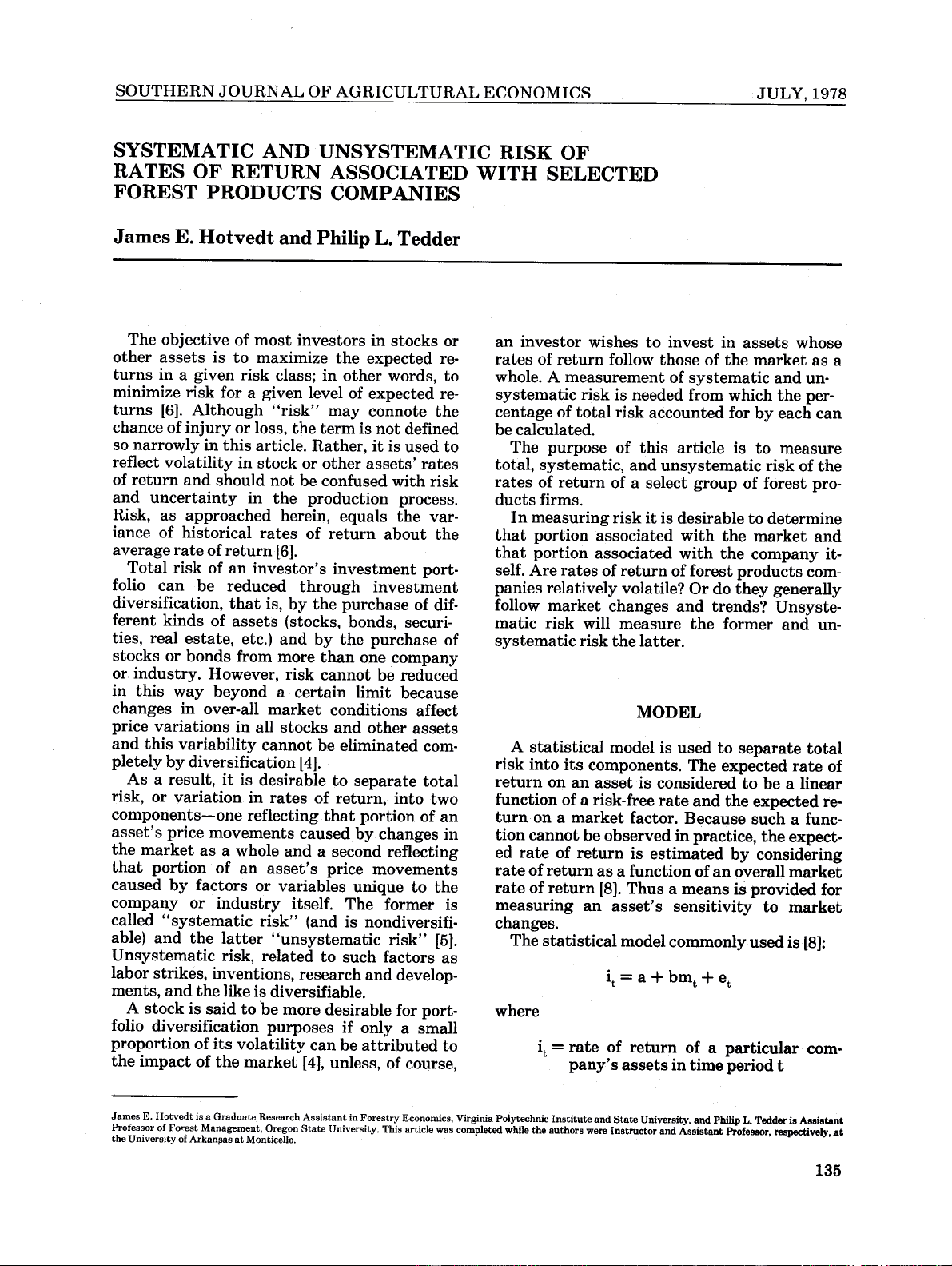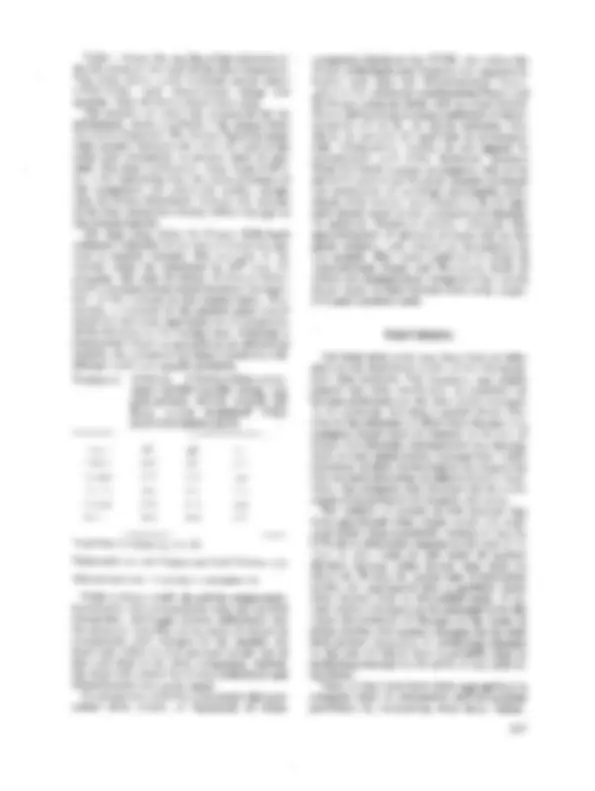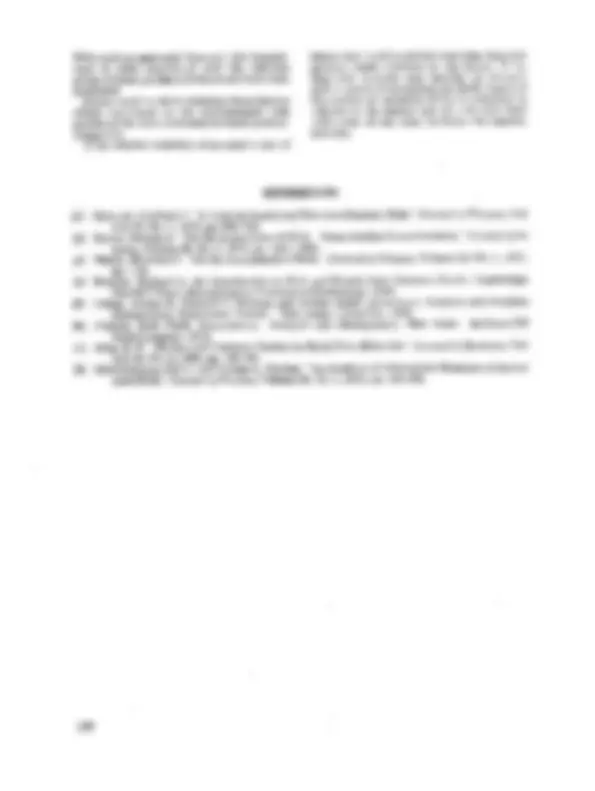




Study with the several resources on Docsity

Earn points by helping other students or get them with a premium plan


Prepare for your exams
Study with the several resources on Docsity

Earn points to download
Earn points by helping other students or get them with a premium plan
Community
Ask the community for help and clear up your study doubts
Discover the best universities in your country according to Docsity users
Free resources
Download our free guides on studying techniques, anxiety management strategies, and thesis advice from Docsity tutors
A research article published in the southern journal of agricultural economics in 1978. The authors, james e. Hotvedt and philip l. Tedder, investigate the total risk, systematic risk, and unsystematic risk of rates of return for a select group of forest products companies. The article explains the concept of risk and its components, and presents a model for separating total risk into systematic and unsystematic risk using regression analysis. The study aims to help investors understand the risk associated with investing in forest products companies and to aid in determining whether large forest products companies are more susceptible to market or industry-specific factors.
What you will learn
Typology: Lecture notes
1 / 4

This page cannot be seen from the preview
Don't miss anything!



ments, (^) and the like is diversifiable.
James (^) E. Hotvedt is a Graduate Research Assistant in Forestry (^) Economics, Virginia Polytechnic Institute and State University, (^) and Philip L. Tedder is Assistant Professor (^) of Forest Management, Oregon State University. (^) This article was completed while the authors were (^) Instructor and Assistant Professor, respectively, at the University (^) of Arkansas at Monticello.
a = y-intercept an^ index^ of^ systematic,^ nondiversifiable risk. b = slope of^ the^ regression^ line^ It^ indicates^ how^ the^ return^ for^ a^ given^ asset M (^) t = market rate^ of^ return^ in^ time^ period^ t^ varies^ with the^ market.^ If^ the^ coefficient^ is and greater^ than^ one,^ an^ asset's^ rate^ of^ return^ in- e (^) t = random error about the regression creases^ (decreases)^ at^ a^ faster^ rate than^ the line in time period t.^ market's.^ This^ value^ indicates^ what^ Francis^ 16] calls an "aggressive asset."^ A^ coefficient^ less For the five^ forest^ products^ companies,^ the^ than^ one^ indicates^ that^ an^ asset's^ rate^ of
assets to be evaluated are^ their^ common^ stocks.^ return^ moves^ counter^ to^ that^ of^ the^ market^ as^ a
The rate of^ return^ (it) on^ each^ company's^ com-^ whole^ [3].
mon stocks is calculated as^ follows^ [6]:^ The^ statistic^ representing^ random^ error^ (e^ t) D + P. -P about the^ characteristic^ line^ cannot^ be^ esti- t t+- Pt mated^ in^ practice.^ Theoretically,^ however,^ it it= represents that portion of total risk^ affected^ by t characteristics unique^ to^ the^ company^ or industry itself.
(^2) ) is a
measure of the percentage of^ total^ risk^ (varia- Dt (^) t = cash dividendcash dividend forfor^ timetime^ periodperiod^ tt tion in the rate of return of the asset) explained Pt+l = common stock price at end of time by changes in the market index. Thus, the coef- period=periodmo tt^ ando ct b iand ficient of determination is that statistic used to
Pt = common stock price at beginning of measure the^ percentage^ of^ total^ risk^ accounted
The market rate of return (M) is reflected by^ EXAMPLE Standard and Poor's^ (SP)^ market^ index^ [4,^ 6]. The market rate of return is calculated^ as:^ unsystematic^ risk Total, systematic, and^ unsystematic^ risk associated with the^ rates^ of^ return^ of^ five SPt+-SPt forest products^ companies^ are^ calculated^ to Mt- p illustrate how the model is used. The firms SPt analyzed are Crown Zellerbach,^ Potlatch, where International^ Paper,^ Westvaco,^ and Weyerhaeuser. Each^ firm^ is^ large,^ having^ land- SP+ = value of^ the^ SP^ index^ at^ the^ end^ of^ holdings^ and processing^ plants^ in^ more^ than the time period^ t^ and^ one^ region^ of^ the^ country.^ The^ analysis^ allows SP = value of the SP index^ at^ the^ begin-^ total^ risk^ and^ its^ components^ for^ each^ of^ the ning of time period t.^ companies^ to^ be^ compared.^ In^ addition,^ the results of such an analysis aid^ in^ determining
Dividends are^ excluded^ purposely^ from^ the^ whether^ large^ forest^ products^ companies^ are market rate^ of^ return^ calculations and^ thus^ the^ more^ or^ less^ susceptible^ than^ companies^ in resulting index is downward biased.^ Provided^ other^ industries^ to^ factors^ that^ affect^ the that dividends are excluded consistently,^ market^ as^ a^ whole,^ or^ to^ factors^ which^ are^ in- comparisons of statistical results and^ of^ risk^ herent^ or^ unique^ to^ the^ particular^ companies^ or are valid [6]. industries^ themselves. The model^ results^ in^ a^ regression^ line,^ often^ TABLE^ 1.^ RESULTS^ OF^ CHARACTERIS- termed a "characteristic line," and the charac- TIC LINE ANALYSIS teristic line reflects the^ "nature^ of^ systematic and unsystematic risks; it^ shows^ the^ relation- ships of some asset with^ the^ market"^ [6].^ ompany^ Charaeristic^ F-Valuea Indeed, the hypothesis is that the rate of (^) Crown Z. i (^) t == 0.05270.0527^ ++^ 1.5491.549^ mt .356.356^ 14. return of an asset^ (it )^ is^ a^ linear^ function^ of^ a market factor common to^ all^ assets^ (Mt )^ and^ of^ Potlatch^ i^ =^ 0.0131^ +^ 0.929^ m^ .312^ 11. an independent^ factor^ unique^ to^ the particular^ Int.^ Pap.^ i^ t^ =^ 0.0631^ +^ 1.0292^ mt^ .242^ 8.
The y-intercept (a) is the asset's rate of Weyco i =0.0732^ +^ 0.9071^ m^ .123^ 3. return when the^ market^ is^ stationary^ (M^ t =^ 0). The beta^ coefficient^ (b)^ is^ a^ measure^ of^ the slope of the characteristic line; it measures the aAll equations and beta coefficients^ are^ significant^ at^ the volatility of an asset's rate of return in relation .05^ level^ except^ those^ for^ Weyerhaeuser^ which^ are^ signifi-
With such an^ approach,^ however,^ the^ compari-^ return^ does^ tend^ to^ persist^ over^ time^ then^ this
sons of risks associated^ with the^ selected^ pattern^ might^ continue^ in^ the^ future.^ If^ so, group of forest products firms would have been^ then^ risk^ analysis^ may^ provide^ an investor
precluded. with^ a^ means^ of^ estimating^ the^ likely^ degree^ of
Future work involves isolating those^ factors^ fluctuation^ or^ variation^ of^ his^ investments^ in which contribute to the unsystematic risk^ relation to^ the market^ and^ the risk^ that^ their portion of the rates of returns to^ forest^ product^ value^ may,^ at^ any^ time,^ be^ below^ his expecta- companies. tions^ [4]. If the relative volatility of^ an^ asset's^ rate^ of
[1] Babcock, Guilford C.^ "A^ Note^ on^ Justifying^ Beta^ as^ a^ Measure^ Risk,"^ Journal^ of^ Finance,^ Vol-
ume 27, No.^ 3,^ 1972,^ pp.^ 699-702. [2] Baesel, Jerome B. "On the Assessment^ of^ Risk:^ Some^ Further^ Considerations,"^ Journalof^ Fi- nance, Volume 29, No.^ 5,^ 1974,^ pp.^ 1491-1494. [3] Blume, MarshallE. "On^ the^ Assessment^ of^ Risk,"^ Journalof^ Finance,^ Volume^ 26,^ No.^ 1,^ 1971, pp. 1-10. [4] Brealey,^ Richard^ A.^ An^ Introduction^ to^ Risk^ and^ Return^ from^ Common^ Stocks,^ Cambridge: The MIT Press, Massachusetts Institute^ of^ Technology,^ 1969. [5] Cohen, Jerome B.,^ Edward^ D.^ Zinbarg,^ and^ Arthur^ Zeikel.^ Investment^ Analysis^ and^ Portfolio Management, Homewood, Illinois:^ Dow^ Jones-Irwin^ Inc.,^ 1973. [6] Francis,^ Jack^ Clark.^ Investments:^ Analysis and^ Management,^ New York:^ McGraw-Hill Book Company, 1972. [7] King, B. F. "Market and Industry Factors^ in^ Stock^ Price^ Behavior,"^ Journalof^ Business,^ Vol- ume 39, No. 2, 1966, pp. 139-190. [8] Schwendiman, Carl J. and George E.^ Pinches.^ "An^ Analysis^ of^ Alternative^ Measures^ of^ Invest- ment Risk," Journalof^ Finance,^ Volume^ 30,^ No.^ 1,^ 1975,^ pp.^ 193-200.